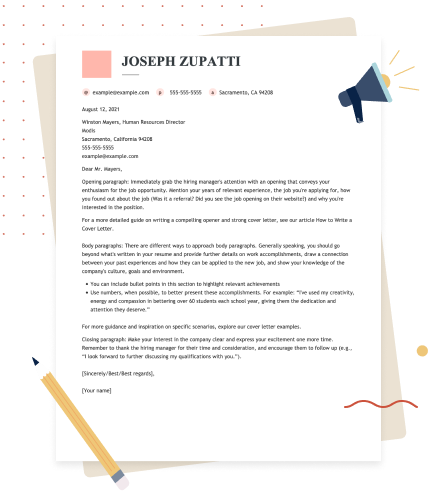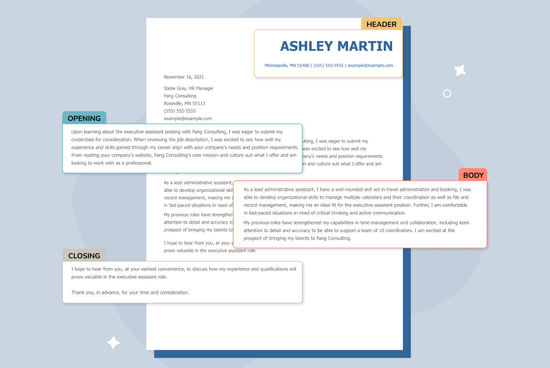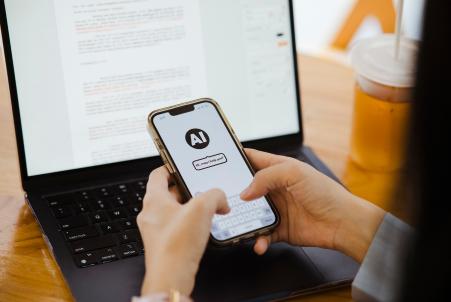Our customers have been hired at: *Foot Note
Creating a cover letter doesn’t have to be complicated. In fact, a simple cover letter can be just as impactful as a lengthy one.
In this guide, we’ll discuss crafting a short cover letter that effectively highlights your strengths, aligns with the job requirements and leaves a lasting impression on employers.
Explore our simple cover letter samples for inspiration and edit them directly in our Cover Letter Generator to create your customized cover letter in minutes.
Simple Cover Letter Examples
To get inspired, take a look at the simple cover letter samples below. Each example showcases the applicant’s qualifications and enthusiasm for the job in 250 words or less.
Learn how to format a cover letter, of any length, with the help of our Cover Letter Format guide.
Simple Cover Letter Template
The simple cover letter template below provides a framework for your cover letter, which can be expanded upon with key skills and quantifiable achievements relevant to the role.
[Your Address]
[City, State, ZIP Code]
[Your Email Address]
[Your Phone Number] [Date] [Hiring Manager’s Name]
[Company Name]
[Company Address]
[City, State, ZIP Code]
Dear [Hiring Manager’s Name],
With a proven track record in [specific skill/field] and a passion for driving [specific value or outcome relevant to the role], I am eager to bring my expertise to the [Job Title] position at [Company Name]. With my background in [mention a key qualification or skill], I am confident in my ability to contribute to your team and support your organization’s goals.
In my previous role at [Previous Company/Organization], I [mention a specific accomplishment or responsibility related to the job]. This experience honed my skills in [specific skills relevant to the role] and reinforced my commitment to [value or goal pertinent to the company].
What excites me most about [Company Name] is your focus on [specific aspect of the company that excites you, such as innovation, teamwork, or a project]. I am eager to bring my [specific strength or quality] to your team and make a meaningful impact.
I would love the opportunity to discuss how my skills and experience align with your needs. Thank you for considering my application, and I look forward to the possibility of contributing to your success.
Sincerely,
[Your Name]
We recommend using one of our professional cover letter templates to quickly and easily craft a simple cover letter highlighting your unique qualifications.
When to Use a Simple Cover Letter
A basic cover letter that succinctly and clearly communicates your qualifications can make a strong first impression, especially when the hiring manager is short on time.
Here are a few scenarios when a simple cover letter could be more impactful than a detailed one:
- You want to make a strong impression on the hiring manager and stand out from other applicants with a succinct yet compelling cover letter.
- You're applying to multiple jobs, and a short cover letter allows you to save time while still customizing it to each position.
- You have limited work experience or qualifications, and a short cover letter allows you to focus on your most relevant skills and achievements.
- You're applying for a position in a field where concise communication is valued, such as journalism or technical writing.
Browse through 200+ cover letter examples for all jobs and career levels. You’ll find a variety of in-depth and simple cover letter examples to spark inspiration.
Benefits of Writing a Simple Cover Letter
A simple cover letter that is concise and focused can quickly grab the attention of the hiring manager by highlighting your most relevant qualifications and enthusiasm for the job.
Here are some of the key benefits of writing a simple cover letter for a job application:
- Saves you time: A short cover letter saves you time during the application process while showcasing your skills and enthusiasm.
- Time-efficient for the employer: Hiring managers appreciate brevity and clarity, as they often review numerous applications.
- Demonstrates clear communication: A simple format ensures your qualifications and interest in the position are easy to find and understand.
- Professional first impression: Simplicity demonstrates your ability to succinctly convey important information, reflecting professionalism and focus.
- Focus on key skills: A basic cover letter emphasizes your most relevant skills and experiences, directly aligning with the job requirements.
Explore our guide on cover letter best practices for additional tips and short cover letter examples to help you craft a job application that wins interviews.
Tips for Writing a Simple Cover Letter
- Use a professional format: The brevity of a short cover letter relates to content, not to formatting. However, it’s important to still use the business letter format to convey your professionalism and attention to detail.
- Open with a succinct value proposition: Start with an attention-grabbing statement that indicates why you are the ideal fit. This is more impactful than stating, “I am excited to submit my application for the position of…”, which can come across as impersonal.
- Showcase job-relevant information: Focus on one or two relevant skills or experiences that match the job description. For instance, instead of detailing multiple projects from past roles, you can focus on one that is highly relevant to the job.
- Add context to your resume: Expand on accomplishments and experience rather than repeating them. Use specific examples to demonstrate your abilities (e.g., "In my previous role, I streamlined scheduling processes, increasing efficiency by 15%").
- Use bullet points: Bullet points are an excellent tool for presenting information clearly and concisely in a short cover letter. Consider incorporating a bulleted list of your most relevant accomplishments that directly align with the job description.
- Incorporate action words: Use action verbs for shorter and more impactful sentences. Action verbs are powerful and concise, and they help demonstrate your impact in fewer words to keep your cover letter short yet effective.
Key Takeaways
- Simple cover letters are short and to the point, making them easy for hiring managers to read and understand quickly.
- A simple cover letter should still use the standard business letter format and follow best practices such as standard font size and adequate spacing between paragraphs.
- Remember to tailor your short cover letter to the job description and focus on one or two key roles are projects that are highly relevant.
- Action verbs and bullet points are helpful space-saving tools for writing a simple and short cover letter that stands out from the competition.
FAQ
How long should a simple cover letter be?
A standard cover letter can be anywhere from around 250-400 words, so if you opt for a shorter version, staying under 250 words is a good starting point.
Explore our guide on the ideal cover letter length for additional tips and examples from certified career experts.
What should you include in a short cover letter?
A short and simple cover letter should include the same key information as a more detailed one, such as a professional cover letter header, contact information and a formal salutation.
Write one body paragraph with your strongest, job-relevant skills and experience to save time and space. If you prefer, use bullet points to get your point across and keep your letter.
To stand out from the crowd, you can also showcase high-income skills that employers value, such as project management or sales.
Include a brief closing paragraph with a clear call to action, avoiding unnecessary wordiness in this section. For additional guidance, take a look at what to include in a cover letter.
How should a simple cover letter be formatted?
A simple cover letter should be formatted with the same formatting conventions as a lengthier one. Here are a few tips to keep in mind:
- Use a simple, clean layout with a consistent font style and size. Avoid using excessive formatting, such as bold or underlined text, as it can be distracting.
- Use a standard font, like Times New Roman, Arial or Calibri, at a 10-12 point size. For consistency, use the same font in your resume and cover letter.
- Use standard margins (1 inch on all sides) to ensure that your cover letter looks neat and well-organized.
- Use bullet points to break up long paragraphs and make your cover letter easier to read. Use them to highlight your most relevant skills and experiences.
- Use white space to make your cover letter more visually appealing and easier to read. Avoid cramming too much text onto one page.
Remember to keep your cover letter concise and focused. Stick to the most relevant and compelling information, and avoid repeating what is already in your resume. Check out our cover letter best practices for more tips.
What information can I leave out of my cover letter?
Make the most of your short cover letter by omitting unnecessary and irrelevant details. Here are a few examples of information you can leave out of your cover letter:
- Redundant details from your resume: Avoid repeating your entire job history or listing your responsibilities verbatim from your resume.
- Irrelevant work experience: Skip details about jobs or experiences that don’t directly relate to the position you’re applying for unless they demonstrate transferable skills.
- Personal information: Leave out details such as age, marital status, religion or hobbies unless they are directly relevant to the job.
- Salary expectations: Only include salary requirements if the job listing explicitly asks for it. Even then, if needed, it’s often better to include this in a separate document.
- Generic statements: Phrases like “I’m a hard worker” or “I’m the perfect fit” are overused and lack specificity. Instead, use measurable achievements and examples.
- Unrelated skills: Focus on the skills that match the job description. For instance, a nursing cover letter doesn’t need to emphasize graphic design skills.
A concise, relevant, professional cover letter introduces hiring managers to your professional background. You can discuss additional qualifications during your job interview.
When should you avoid using a short cover letter?
Avoid a short cover letter in these scenarios:
- If you’re applying for a position in academics, the communication industry or a career that requires a prolific writer, like a grant specialist or ghostwriter, among others.
- If you’re in the midst of changing careers, an employer will notice your previous work experience in your resume. A cover letter will help you explain your interest in the new industry and what you could bring to the table.
- Avoid using a cover letter of any length if the job application requests no cover letters.
See answers to the question, “Are cover letters necessary?” for additional guidance from career advice experts.
How can I make a simple cover letter quickly?
You can use our Cover Letter Builder to make a basic cover letter in a matter of minutes. We also recommend using our Resume Builder to create a resume for your job application.
You can use a matching cover letter and resume template to ensure that your job application is cohesive and polished.
We also recommend checking out our guide on how to use ChatGPT to write a cover letter for tips and precautions from career experts.
How we reviewed this article
Since 2012, we have helped more than 11 million job seekers. We want to make your career journey accessible and manageable through our services and Career Center’s how-to guides and tips. In our commitment to bring you a transparent process, we present our Editorial Process.
Our customers have been hired at:*Foot Note







